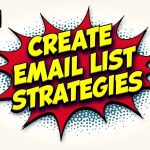So, you’re ready to take your email marketing to the next level? Great! Prepare to become an email marketing campaign ninja… or at least stop sending emails that get immediately banished to the spam folder.
You’re already familiar with the basics, but now it’s time to dive into how to build email campaigns that actually deliver results related to types of email campaigns can enhance your marketing strategies.
This guide will walk you through the essential steps, from list building (aka, ethically gathering email addresses without resorting to carrier pigeons) to analyzing your performance (so you can finally prove to your boss that you’re not just randomly hitting send). Let’s get started! May the open rates of your email subject lines be ever in your favor!”
Step 1: Supercharge Your Marketing Automation & List Building Efforts
Having a healthy and engaged email list is the foundation of any successful email marketing effort. Think of it as the sourdough starter of your email empire – without it, you’re just sending out flat, lifeless content that nobody wants to consume.
Forget simply adding a signup form to your website and hoping people stumble upon it like they’re lost in the digital wilderness. Let’s explore some creative and effective list building strategies that will attract the right subscribers. We want the subscribers who are genuinely interested in what you have to offer, not the ones who signed up by accident while trying to find cat videos (although, hey, maybe you can offer cat videos!).
- Offer a High-Value Lead Magnet to attract subscribers to your email marketing tool. A lead magnet is an irresistible offer you provide in exchange for an email address. Think beyond a generic “subscribe to our newsletter.” Create something truly valuable and relevant to your target audience.
- Examples:
- Ebook or Guide: Create a detailed guide related to your industry or product. For example, if you sell coffee, offer a “Beginner’s Guide to Brewing the Perfect Cup at Home.”
- Checklist or Template: Create email content that captivates your audience. These are quick and easy to consume. Offer a checklist for “Optimizing Your Website for Mobile” or a template for “Creating a Social Media Content Calendar.”
- Free Trial or Discount: If you offer a product or service, provide a free trial or a special discount for new subscribers.
- Webinar or Online Course: Host a free webinar or mini-course on a relevant topic. This is a great way to build authority and generate leads.
-
Actionable Tip: Make sure your lead magnet is highly relevant to your target audience and delivers on its promise. Promote it prominently on your website, social media channels, and even in your email signature.
- Examples:
- Run Contests and Giveaways: Everyone loves a chance to win something! Run contests and giveaways to generate excitement and attract new subscribers.
- Examples:
- Product Giveaway: Give away one of your products or services.
- Gift Card Giveaway: Offer a gift card to your store or a popular online retailer.
- Partner with Other Businesses: Collaborate with other businesses in your industry to offer a larger prize package for your email newsletter.
-
Actionable Tip: Use a contest platform like Rafflecopter or Gleam to manage your contest and make it easy for people to enter. Be sure to promote your contest widely on social media and use relevant hashtags.
- Examples:
- Create Engaging Quizzes and Surveys: Quizzes and surveys are a fun and interactive way to collect email addresses and learn more about your audience.
- Examples:
- Personality Quiz: Create a quiz that tells people something about themselves based on their answers. For example, “What Type of Coffee Drinker Are You?”
- Product Recommendation Quiz: Help people find the right product for their needs by creating a quiz that asks them about their preferences.
- Market Research Survey: Ask your audience about their challenges and needs to gain valuable insights for your business.
-
Actionable Tip: Use a quiz or survey platform like Typeform or SurveyMonkey to create your email content for the quiz or survey. Be sure to offer an incentive for people to complete it, such as a discount code or a free gift.
- Examples:
- Leverage Social Media: Don’t just rely on your website to collect email addresses. Use social media to promote your lead magnet, contest, or quiz and drive traffic to your signup form.
- Examples:
- Run Facebook Ads: Target your ideal customers with Facebook ads that promote your lead magnet or contest.
- Use Instagram Stories: Create engaging Instagram Stories that encourage people to swipe up and sign up for your email list.
- Host a Twitter Chat: Host a Twitter chat on a relevant topic and encourage people to sign up for your email list to receive a summary of the chat.
-
Actionable Tip: Use social media analytics to track your results and see which strategies are working best.
- Examples:
- Offer Exclusive Content: Create content that is only available to your email subscribers. This could be anything from a weekly newsletter to a private Facebook group.
- Examples:
- Weekly Newsletter: Share exclusive content, tips, and resources with your subscribers.
- Private Facebook Group: Create a private Facebook group where you can connect with your subscribers and answer their questions.
- Early Access to New Products: Give your subscribers early access to new products or services.
-
Actionable Tip: Make sure your exclusive content is truly valuable and worth signing up for. Promote it prominently on your website and social media channels.
- Examples:
Step 2: Master the Art of Segmentation is a crucial aspect of successful types of email campaigns. for your Email Campaign

Segmentation is the key to sending emails that don’t make your subscribers immediately hit the ‘unsubscribe’ button faster than you can say ‘batch and blast.’ Instead of sending the same message to everyone on your list – which is basically the digital equivalent of shouting the same thing at a crowded stadium and hoping someone cares – segmentation allows you to tailor your email campaigns.
Think of it as whispering sweet nothings (or, you know, relevant offers) to specific groups of subscribers based on their demographics, behavior, and interests. Because let’s be honest, nobody wants to get an email about dentures when they’re clearly still rocking a full set of pearly whites!
- Why is Segmentation Crucial?
- Increased Engagement can be achieved through targeted marketing strategies in your email content. When you send relevant emails, people are more likely to open, read, and click on them.
- Higher Conversion Rates: Targeted emails lead to higher conversion rates because they address the specific needs and interests of your audience.
- Improved Deliverability: Email providers like Gmail and Yahoo are more likely to deliver your emails to the inbox if they see that your subscribers are engaged.
- Stronger Customer Relationships: Segmentation allows you to build stronger relationships with your customers by showing that you understand their needs.
- How to Segment Your List:
- Demographics: Segment your list based on factors like age, gender, location, and income.
- Example: If you sell clothing, you could segment your list by gender and send different emails to men and women.
- Behavior: Segment your list based on how people interact with your website and emails.
- Example: You could segment your list based on whether people have purchased from you before, how often they visit your website, or which emails they have opened.
- Interests: Segment your list based on the topics that people are interested in.
- Example: If you sell books, you could segment your list by genre and send different emails to people who are interested in fiction, non-fiction, or mystery.
- Purchase History: Segment based on past purchases.
- Example: If a customer bought a specific product, you can send follow-up emails with related items or special offers.
- Lead Magnet Download: Segment based on the lead magnet they downloaded to tailor your email content effectively.
- Example: If someone downloaded your guide on “Advanced SEO Techniques,” you know they’re interested in SEO and can send them related content.
- Website Activity: Track which pages users visit on your website.
- Example: If someone spends a lot of time on your “gardening” section, you can add them to a “gardening enthusiasts” segment.
- Demographics: Segment your list based on factors like age, gender, location, and income.
Actionable Tip: Start with a few basic segmentation criteria and gradually add more as you learn more about your audience. Don’t overcomplicate things – focus on the segments that will have the biggest impact on your results.
Step 3: Design a Successful Email Marketing Campaign That Captivates
Your email design plays a crucial role in grabbing attention and encouraging clicks. In today’s mobile-first world, it’s essential to create visually appealing and mobile-friendly emails that look great on any device.
- Key Email Design Principles:
- Mobile-First Design: Make sure your emails are responsive and look great on smartphones and tablets. Use a mobile-friendly email template and test your emails on different devices.
- Clear and Concise Messaging: Get straight to the point and use clear, concise language. Avoid jargon and focus on the benefits of your offer.
- Visually Appealing Layout: Use a clean and uncluttered layout with plenty of white space. Use images and videos sparingly and make sure they are high-quality and relevant.
- Strong Call to Action: Use a clear and compelling call to action that tells people what you want them to do. Use action-oriented language and make your call to action button stand out.
- Brand Consistency: Use your brand colors, fonts, and logo to create a consistent brand experience.
- Tips for Creating Effective Email Design:
- Use High-Quality Images: Use high-quality images that are relevant to your message. Avoid using stock photos that look generic.
- Optimize Images for Email: Compress your images in your marketing email to reduce their file size and improve loading times, following best practices for email design.
- Use a Consistent Font: Use a consistent font throughout your email. Choose a font that is easy to read and that matches your brand.
- Use White Space Effectively: Use white space to create a clean and uncluttered layout. White space helps to guide the reader’s eye and make your email easier to scan.
- Test Your Emails to ensure they align with the best email marketing practices. Always test your emails on different devices and email clients to make sure they look great.
Actionable Tip: Use an email marketing platform that offers a drag-and-drop email editor like Getresponse. This will make it easy to create visually appealing and mobile-friendly emails without having to code.
Step 4: Harness the Power of Email & Marketing Automation
Email automation is a game-changer for saving time and nurturing leads. By setting up automated email sequences, you can deliver the right message to the right person at the right time, without having to manually send each email.
- Essential Email Automation Sequences:
- Welcome Emails: Send a welcome email to new subscribers to thank them for signing up and introduce them to your brand.
- Example: A welcome email could include a thank you message, a brief overview of your brand, a link to your most popular content, and a special offer.
- Abandoned Cart Emails: Send an email to people who have added items to their cart but haven’t completed their purchase.
- Example: An abandoned cart email could include a reminder of the items in their cart, a special discount, and a link to complete their purchase, showcasing different types of email.
- Lead Nurturing Campaigns: Send a series of emails to nurture leads and guide them through the sales funnel.
- Example: A lead nurturing campaign could include types of email that provide valuable information, address common objections, and offer a free trial or demo.
- Post-Purchase Emails: Send emails after a customer makes a purchase to thank them, provide shipping information, and ask for feedback.
- Example: A post-purchase email could include a thank you message, a tracking number, a link to a customer satisfaction survey, and a recommendation for related products.
- Re-engagement Campaigns: Target inactive subscribers to try and re-engage them.
- Example: Offer a special discount or remind them of the value they get from being on your list. If they still don’t engage, consider removing them to maintain a healthy list.
- Welcome Emails: Send a welcome email to new subscribers to thank them for signing up and introduce them to your brand.
- Setting Up Email Automation:
- Choose an Email Marketing Platform: Select an email marketing platform that offers email automation features.
- Define Your Goals: Determine what you want to achieve with your email automation sequences.
- Map Out Your Sequences: Create a flowchart or diagram that outlines the emails in your sequence and the triggers that will send them.
- Write Your Emails: Write compelling and engaging emails that are tailored to each stage of the customer journey.
- Set Up Your Triggers: Configure the triggers that will send your emails, such as when someone signs up for your list, abandons their cart, or makes a purchase.
- Test Your Sequences: Thoroughly test your email automation sequences to make sure they are working properly.
Actionable Tip: Start with a simple welcome email sequence and gradually add more complex types of email campaigns. email automation sequences as you become more comfortable with the process.
Step 5: Analyze and Optimize Your Performance for Effective Email Marketing

Tracking your email marketing metrics is essential for understanding what’s working and what’s not. By analyzing your performance, you can identify areas for improvement and optimize your email campaigns for better results.
- Key Email Marketing Metrics:
- Open Rate: The percentage of people who opened your email. A good open rate is typically around 20-30%.
- Click-Through Rate (CTR): The percentage of people who clicked on a link in your email. A good CTR is typically around 2-5%.
- Conversion Rate: The percentage of people who took the desired action after clicking on a link in your email, such as making a purchase or filling out a form.
- Bounce Rate: The percentage of emails that could not be delivered. A high bounce rate can damage your sender reputation.
- Unsubscribe Rate: The percentage of people who unsubscribed from your email list. A high unsubscribe rate can indicate that your emails are not relevant or engaging.
- How to Track Your Metrics:
- Use Your Email Marketing Platform: Your email marketing platform will provide you with detailed reports on your email campaign performance.
- Set Up Goals in Google Analytics: Track your email campaign conversions by setting up goals in Google Analytics.
- Use UTM Parameters to track the effectiveness of your best email marketing campaigns. Use UTM parameters to track the performance of your email campaigns in Google Analytics.
- How to Use Data to Improve Your Campaigns:
- Analyze Your Open Rates: If your open rates are low, try improving your subject lines or sending your emails at a different time of day.
- Analyze Your Click-Through Rates: If your click-through rates are low, try improving your email design, your call to action, or the relevance of your content.
- Analyze Your Conversion Rates: If your conversion rates are low, try improving your landing page, your offer, or your checkout process.
- A/B Test Everything: Test different subject lines, email designs, and call-to-actions to see what works best.
Actionable Tip: Don’t just look at the numbers – try to understand the “why” behind them. Why are people not opening your emails? Why are they not clicking on your links? By understanding the reasons behind your performance, you can make more informed decisions about how to improve your email campaigns.
Putting It All Together
Creating a successful email marketing campaign takes time and effort, but it’s well worth it. By following these steps, you can build a thriving email list, engage your subscribers, and drive more sales for your business. Remember to stay consistent, test everything, and always focus on providing value to your audience. Good luck!
TLDR – Too Long Didn’t Read
This guide provides a step-by-step approach to crafting effective email marketing campaigns. It covers building an engaged email list through valuable lead magnets, segmenting your audience for personalized messaging, designing captivating and mobile-friendly emails, automating email sequences for efficiency, and analyzing key metrics to optimize performance. The goal is to create valuable, targeted emails that drive engagement and conversions.




